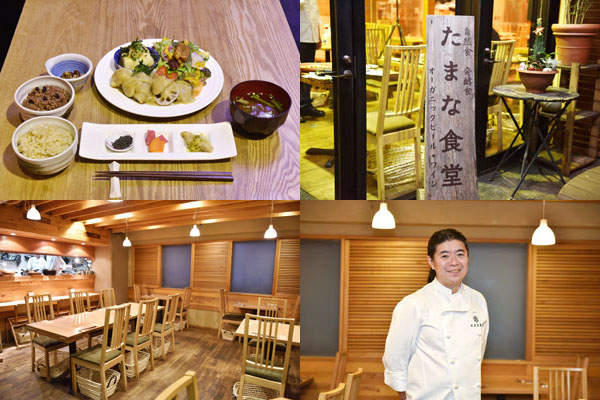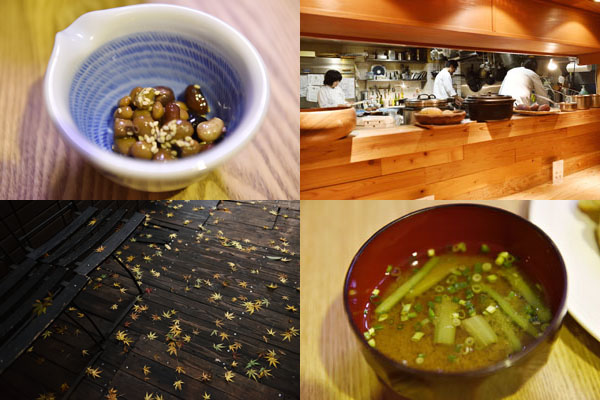Tamana Shokudo: Aoyama's Brown Rice & Vegetable Spot
Jan 17,2017
Tamana Shokudo: Aoyama's Brown Rice & Vegetable Spot
Jan 17,2017
Regular Japanese meals have long been enriched by many fermented foods including miso, soy sauce, vinegar, mirin rice wine, and fermented natto soybeans. Fermented foods and their umami flavorings are produced by the actions of endemic microorganisms and offer a host of benefits to the human body. Fermented foods, moreover, represent the crystallization of Japan’s great wisdom produced by our ancestors. In this series, we present the people and establishments connecting the fermented foods of today to future generations as well as fermented food recipes. For Part 7, we visited Tamana Shokudo, a vegetarian, brown rice restaurant located in Tokyo’s Minami Aoyama district.
▶Kamoshika Fermentation Shokudo: A Unique Fermentation Diner
▶Tokuyama Zushi: Renowned Fermented Food in Shiga

Tamana Shokudo is a restaurant that focuses on brown rice, organic vegetables, and fermented foods. Head chef Kumon Kiichi, who trained at starred restaurants in France, now puts his culinary skills on display at Tamana Shokudo.
“Brown rice and vegetarian food might bring to mind a rather plain menu, but our dishes are full of flavor, are very filling, and look gorgeous.”
Although the food may not look it, the ingredients are healthy in the truest sense of the word. Most of the ingredients are seasonal vegetables sourced from Wakayama, the chef’s home prefecture, and are brought to perfection with handmade fermented seasonings. Straightaway, we ordered the Tamana set menu, the classic of the classics.
The main dish is a large platter nearly overflowing with a mound of vegetables. The steamed vegetables — including lotus root, anno sweet potato, taro, cauliflower, broccoli, kintoki carrots, and eringi mushrooms — are covered in a generous amount of the restaurant’s special salted koji malt bagna cauda sauce. The sauce’s base is a vegetable paste made from Chinese cabbage, cabbage, daikon radish, celery, garlic, onions, and other vegetables. The sauce, which is tossed with homemade salted koji and organic extra virgin olive oil from Turkey, has a rich, profound flavor. It is the perfect match for the steamed vegetables.
Tempeh, sometimes called the natto of Indonesia, is cultured by binding a fungus called tempeh starter to boiled soybeans. Among the set menu’s many softer vegetables, the dish of tempeh and three types of nuts really stands out. The organic raw vegetables, including daikon radish, sunny lettuce, and bok choy, are topped with a vegetable and fruit dressing.
The small dish contains deep-fried tofu topped with local seaweed and grated daikon radish. The small bowl contains natto made from fermented Hokkaido-grown green soybeans and black beans. The obanzai (assorted side dishes) include nukazuke pickles made from carrots, black sesame salt, and red turnips pickled in sweet vinegar. Although the menu is entirely vegetable-based, the variety of flavors and textures keeps you munching ravenously without getting bored.
The miso soup is made with vegetable broth. The miso is dissolved in a gentle broth made from vegetable peels, seeds, stems, and other scraps, allowing the miso’s richness and the vegetables’ sweetness to seep gradually into the body.
We were served two types of rice. The Tamana set menu’s brown rice is from the Kumano area in Wakayama. It is called Nachi no Megumi and is produced with a pyrrole farming technique that utilizes cyanobacteria. This brown rice, which grows robustly in an area with large temperature variations, is rich in minerals and has a chewy texture much like white rice, along with a pleasant fragrance and a distinct sweet, mellow flavor. The other rice is an enzyme-activated brown rice that is first cooked at pressures over 1.8 times atmospheric pressure in a specialized rice cooker and then aged for over three days. This results in a rice with a sweeter taste and chewier texture.
The set menu offers a number of side dishes that take full advantage of their ingredients’ exquisite and rich flavors. With the Tamana set menu, the more you chew, the greater the flavor. It’s amazing that you can get around 40 types of ingredients in just this one meal. In addition to the set menu, we tasted the soy sauce koji stir-fry with organic vegetables and the natto canapes marinated in salted koji that would make excellent drink snacks. We lost count of the dozens of types of ingredients we had. Our stomachs must have been pleasantly surprised.


In the back of Tamana Shokudo is the Tamana School, a space where cooking classes are held. Here, students learn how to make miso, soy sauce, and mirin as well as how to cook brown rice and vegetarian meals.
We hear from Tsutsumi Yukiko, one of the school’s instructors. “Winter is the best season to prepare miso. After it is prepared, homemade miso is left to slowly ferment for about 10 months, which accounts for its truly special flavor. Once you taste it, you’ll be hooked and find yourself preparing it every year. (laughs)” Miso prepared in winter (cold-season miso) is stored at room temperature. As the temperatures warm up, the enzymes become more active, and once the summer has past, the miso will have fully matured and its umami intensified. Homemade miso prepared with pesticide-free brown rice, soybeans, and natural salt cannot be anything but delicious.
“Typical miso is made with white rice koji, but in our classes, we prepare miso with either brown rice koji or barley koji and do taste comparisons. Brown rice koji brings out more of a distinctive aroma, while barley koji makes the aroma even more assertive. In our classes, we also make convenient, versatile seasonings such as soy sauce koji, salted koji, sweet koji, soy sauce, salted mirin, yuzu citrus ponzu sauce, and apple vinegar.”
Once you eat something delicious, you naturally want to try to make it on your own. So it’s not surprising that people who were impressed by the food at Tamana Shokudo go on to join the classes. In the past, fermented food recipes were preserved by handing them down from grandmother to mother to daughter. In our day and age, the same knowledge can also be passed from restaurants to customers.

▶Kamoshika Fermentation Shokudo: A Unique Fermentation Diner